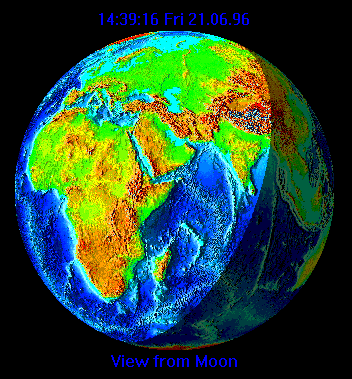Earth Screen Saver for Windows
by John Walker
WWW Home page: http://www.fourmilab.ch/

The Earth screen saver displays an image of the Earth as currently
illuminated by the Sun, from a variety of viewpoints. You can view
the Earth from the Sun (day side), the night side, from the Moon, or
from an arbitrary altitude above any point on the globe specified by
latitude and longitude. Day and night regions of the globe are shown
based on the current date and time. The image of the Earth shifts
location on the screen every 10 minutes to avoid burning in the
phosphor in one location.
The Earth Screen Saver is available exclusively for 32-bit Windows systems
such as Windows 95 and Windows NT.
The Earth Screen Saver is in the public domain. You can do anything you
like with it.
The images are generated based on
a global topographic map
developed by the
Marine Geology and Geophysics Division
of the National Geophysical Data Center
operated by the United States Department of Commerce,
National Oceanic and Atmospheric Administration.
Downloading and Installation
After you've downloaded the program archive, extract the files
in it with PKUNZIP or a compatible
archive extract program, and follow the instructions in the included README.TXT file
to install, configure, and activate the screen saver on your system.
Home Planet
The Earth Screen Saver was developed based on
Home Planet, a
comprehensive Earth and sky simulator for Windows which displays the
Earth, tracks satellites, asteroids, and comets, includes an
extensible multimedia object catalogue, a simulated telescope for
viewing the sky at any magnification or location, a database of more
than a quarter million stars, and a complete hypertext help file and
introduction to astronomy linked to the components of the program.
Displays include the illuminated portion of the Earth, the Sky, the
Telescope, the Earth as viewed from a satellite, the Moon, or the Sun,
an orrery, panels displaying current information about the Moon and
planets, and more. Real-time astronomical information can be exported
to other applications via DDE. There's even a cuckoo clock (you can
turn it off).
Related software on this site
- Web resources:
- Earth Viewer.
- Solar System Live: interactive orrery.
- Terranova: a new terraformed planet every day.
- For Windows:
- Home Planet,
- Moontool,
- an Excel catalogue of the Palomar
Observatory Sky Survey, and
- Craters screen saver,
- Sky screen saver,
- Slide Show screen saver,
- Bullets screen saver,
- Millennium screen saver.
- For Unix (X/OpenWindows):
- Moontool and
Xsunclock.
Source Code
Experienced C programmers who wish to modify the screen saver or
simply look under the hood to see how it works may download the source
code. You're welcome to use this source code in any way you like, but
absolutely no support is provided for it--you're on your own.
by John Walker

